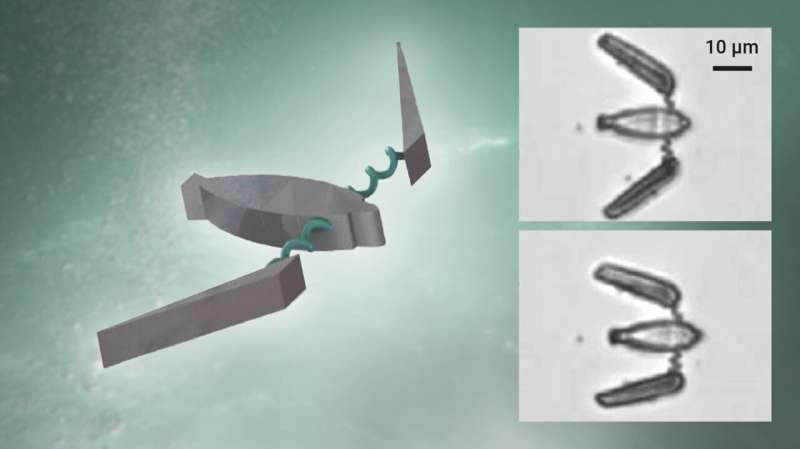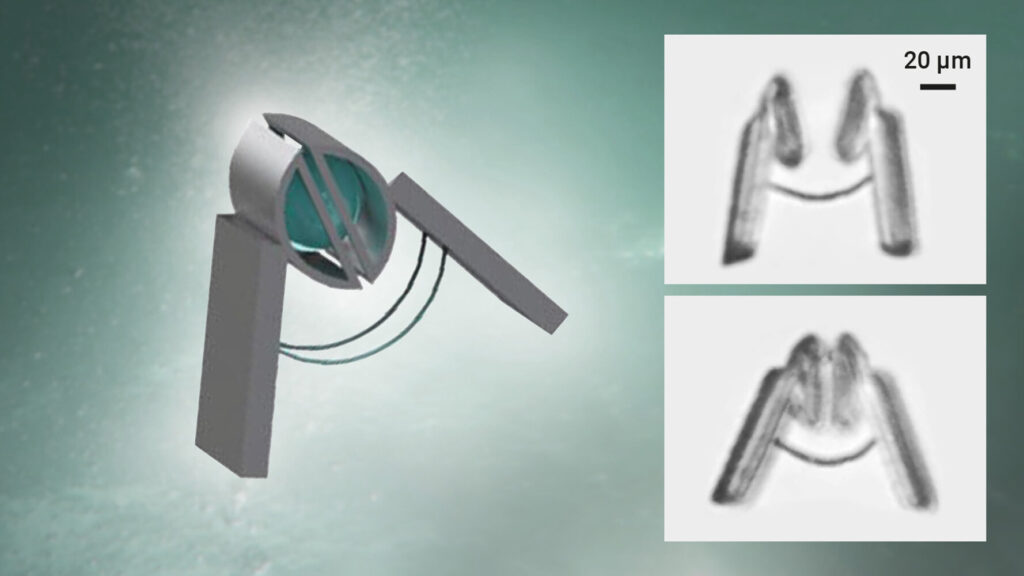The integration of mechanical memory in the form of springs has for hundreds of years proven to be a key enabling technology for mechanical devices (such as clocks), achieving advanced functionality through complex autonomous movements. Currently, the integration of springs in silicon-based microtechnology has opened the world of planar mass-producible mechatronic devices from which we all benefit, via air-bag sensors for example.
For a new generation of minimally and even non-invasive biomedical applications however, mobile devices that can safely interact mechanically with cells must be achieved at much smaller scales (10 microns) and with much softer forces (pico Newton scale, i.e., lifting weights less than one millionth of a mg) and in customized three-dimensional shapes.
Researchers at the Chemnitz University of Technology, the Shenzhen Institute of Advanced Technology of the Chinese Academy of Sciences and the Leibniz IFW Dresden, in a recent publication in Nature Nanotechnology, have demonstrated that controllable springs can be integrated at arbitrary chosen locations within soft three-dimensional structures using confocal photolithographic manufacturing (with nanoscale precision) of a novel magnetically active material in the form of a photoresist impregnated with customizable densities of magnetic nanoparticles.
These “picosprings” have a remarkably large and tunable compliancy and can be controlled remotely through magnetic fields (even deep within the human body) allowing articulated motion in microrobots as well as micromanipulations well beyond the state of the art.
Moreover, the extension of the picosprings can also be used visually to measure forces, for example propulsion or grasping forces, in interaction with other objects like cells. For example, these picosprings have been used to measure the locomotive propulsion force of sperm cells.
The publication showcases these capabilities by demonstrating several microbots (including a micropenguin) containing picosprings at multiple locations that can do these tasks at cellular scales: propel themselves, grasp and release cells and measure the minute forces needed to do this safely.

Dr. Haifeng Yu, first author of the study and group leader at the Chinese Academy of Sciences in Shenzhen (China), says, “Programmable elasticity at the micrometer scale offers a feasible strategy for producing 3D devices and finely structured ‘micro-surgeons’ capable of performing complex medical tasks.”
Dr. Mariana Medina-Sanchez, group leader at the Leibniz IFW and BCUBE- TU Dresden, co-author and co-supervisor of this work, adds, “These picospring-based micromachines with programmable elasticity and magnetism, crafted through monolithic fabrication, open numerous possibilities for localized force sensing and actuation in low Reynolds number environments. This versatility underscores their significance across a spectrum of biomedical applications.”
Prof. Oliver Schmidt, who is last author of the paper and supervised this work, sees this as another important step in the transition toward life-ready soft and smart modular microrobotics. “Remotely controlled microdevices using magnetic fields form a particularly promising technology for non-invasive medical applications—and now this extends to mechanical mechanisms inside these remote microdevices,” says Schmidt.
“Being able to incorporate designer springs will also add a new tool to the growing capability at TU Chemnitz towards microelectronic morphogenesis and artificial life,” adds Prof. John McCaskill, co-author of the study, member of the Research Center MAIN, and founding director of the European Center for Living Technology.


